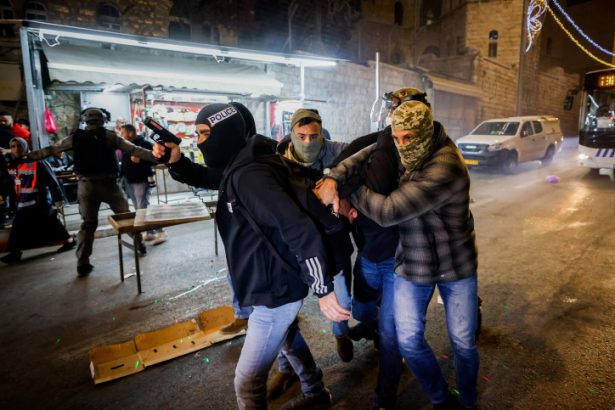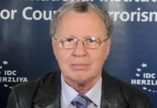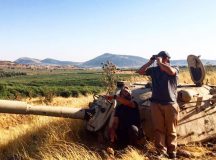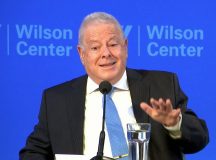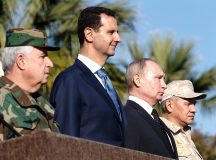On 4 April deputy editor Samuel Nurding spoke with Dr Ely Karmon about the recent terrorist attacks in Israel, the level of ISIS support in Palestinian society and why Jenin is (once again) the terror capital of the West Bank. Dr Ely Karmon is a senior research scholar at the Institute for Counter Terrorism, based in Reichman University. Below is an edited transcript of Ely’s remarks.
The Perpetrators
The first two terrorist attacks were the first in Israel that were inspired by ISIS. The third, in the heart of the orthodox city of Bnei Brak, was allegedly carried out by a Fatah militant. [For details on the fourth attack see the Addendum.) ISIS does not have a recognised affiliate in Israel. In the past, several Jihadists in the Gaza Strip asked the ISIS Caliph to recognise their status as ISIS fighters, but he refused. This was also the case with those jihadist fighters in the Strip who presented themselves as an al-Qa’eda faction. They were not recognised as such by al-Qa’eda Central.
The Context: ISIS in Israel
It is important to understand the context of the attacks. There is now an ISIS presence inside the Israeli Arab (and Palestinian) community. Only about 200 Palestinians from Gaza, the West Bank and Israel tried to go and fight for ISIS. Some managed to leave, but many didn’t. For instance, the terrorist who committed the Beer Sheva attack was an influential preacher for ISIS in 2013/14 who had been arrested and put on trial when he attempted to travel to Syria. One of the terrorists of the Hadera attack also tried to get into Syria from Turkey but was arrested by the authorities, expelled back to Israel, and subsequently spent several years in jail. The government policy towards those fighters who returned to Israel was that if the fighters were not found responsible for severe crimes against humanity, they were put in jail only for two or three years. In Israel, some 86 known supporters of ISIS were jailed.
Israel’s intelligence services are challenged by a huge amount of potential terrorist activity from Gaza, the West Bank, in Israel itself and from the northern front in southern Lebanon and southern Syria. In the last few months, the expectation in Israel was that tensions would likely rise during Ramadan in Jerusalem and the surrounding areas, as Hamas and the Palestinian Islamic Jihad (PIJ) tried to destabilise the situation around the Temple Mount to maintain their status as ‘defending’ the al-Aqsa Mosque.
But over the last few months there has been a resurgence of ISIS activity in Syria. It culminated with an ISIS attempt to break out over 3,500 of its fighters imprisoned by Kurdish forces. This attempt to liberate ISIS fighters was a strategy first conceived in 2009. Called ‘Breaking of the Walls’, a series of attacks were carried out under ISIS commanders to free hundreds of Jihadist prisoners in Iraq, who then came to form the bulk of the ISIS fighting force in Syria.
The Sinaa Prison, where 3,500 ISIS prisoners, alongside 700 minors (‘Cubs of the Caliphate’) were detained, was attacked in January 2022 by groups affiliated with ISIS. Concurrent with the attacks, thousands of prisoners began to mutiny inside the prison, hundreds managed to escape to the adjacent neighbourhood. It took about 10 days for Kurdish forces, with the help of Americans and British planes, to recapture those that managed to escape – about 600. The attack ended with the killing of dozens of ISIS fighters and detainees inside the prison, in addition to approximately 140 members of the Syrian Democratic Forces (SDF) and its prison guards.
Only days after, on 3 February 2022, Abu Ibrahim al-Hashimi al Qurayshi, ‘the Caliph of ISIS’, who was hiding close to the prison itself, was killed in an American operation, a significant setback for the organisation. Possibly, al- Qurayshi was there in order to take command of the freed prisoners and continue the fight to retake territory within the Kurdish enclave.
On 10 March ISIS officially announced the death of the Caliph and the nomination of a new one, Abu Hasan al-Hashemi al-Qurayshi. The ISIS media team started a global campaign drumming up allegiance for the new Caliph and asked followers to avenge the death of Abu Ibrahim al-Hashimi al Qurayshi by targeting its enemies, including regional Arab states and the West.
This is exactly what happened in Israel in the Hadera attack: one of the terrorists wore a vest on which was an image taken from the Netflix series Avengers, to show the attack was following the directive of ISIS to avenge the death of the Caliph.
That said, although the terrorists carried out the attack in the name of ISIS, there was no explanation by them how it related to the organisation.
The main article of the ISIS a-Naba journal dealt with the attack in Hadera and presented it as an ‘oath of allegiance to the leader of the organisation’ but did not add new details about the terrorists or if they had previous links to the organisation. The article expressed resentment over the Palestinians who condemned the attack: ‘Their goals and interests intersected with the Jews’.
The attacks were a failure of Israel’s intelligence services which did not pay enough attention to the dramatic events in Syria and the message calling for revenge attacks issued after the death of the Caliph. In Beer Sheva, it was clear that the attacker was an ISIS sympathiser, and that the security service should have arrested or immediately monitored all known ISIS supporters after that message. This has subsequently happened after the Hadera terrorist attack.
Jenin: Terror Capital
The terrorist behind the third attack in Israel, in Bnei Brak, came from Jenin and was a member of Fatah. What is worrying is that despite the condemnation of the attacks by Palestinian Authority (PA) Chairman Mahmoud Abbas, which was rare in itself, the head of the Fatah movement in Jenin praised the terrorist and described him as a martyr. This is the state of play within the PA and the dominant Fatah movement and shows how low is the standing and legitimacy of Abbas in the West Bank.
Ever since the Second Intifada in 2000, Jenin has been a stronghold for the Gaza-based Palestinian Islamic Jihad. In fact, the start of Defensive Shield Operation in late March 2002 – launched after a series of terrorist attacks had killed 130 Israeli civilians in one month – began with the entrance of IDF soldiers into Jenin. Ever since, the battle inside the refugee camps in Jenin, where some 52 Palestinians, mostly gunmen, and 23 IDF soldiers were killed in the fighting, came to symbolise the fight against terrorism for the IDF in the West Bank. However, the terrorist infrastructure was rebuilt in the city and today the PA security forces do not control Jenin and have huge difficulties entering the city to fight the local extremists.
The PIJ has its stronghold in Jenin, and it is known that its militants cooperate closely with Fatah elements in the city. The question is if the two individual attacks by allegedly Fatah militants were possibly a joint operation of the two groups or signalled a switch of allegiance from Fatah to PIJ.
Abbas and security cooperation with Israel
The PA Security Forces (PASF) are practically cooperating with Israel in the fight against Hamas and PIJ and this is very important as it allows Israeli forces to enter the Area A in West Bank when necessary to prevent future attacks from materialising. Hundreds of Hamas and PIJ operatives have been arrested by the PASF. They are not put on trial, but rather imprisoned without trial for months or years, (as happens in Gaza when Fatah activists are arrested by Hamas). In a recent speech Abbas was emphatic that security cooperation with Israel is a ‘must’, a ‘holy mission’. At the same time, incitement for attacks is still strong within the Fatah movement, and the Palestinian Authority is still paying money to imprisoned terrorists and their families, even those that belong to Hamas and PIJ.
It is very difficult to know exactly how the Palestinian street in the West Bank feels about the terrorist attacks. We know that during the ‘knife intifada’ in 2015 and 2016, many young people supported Hamas. In some places, such as Jenin and Nablus, there is more support for armed resistance against Israel, as well as large families who historically support Hamas. It’s important to remember that when Hamas took control of the Palestinian parliament in 2006, Fatah actually received 700,000 more votes, only losing the elections because Abbas’s Fatah list was split between supporters of Marwan Barghouti and 75 other Fatah candidates. It is for the same reason that Abbas cancelled the elections in May 2021, as the Fatah vote would have been split among three lists. That cancellation triggered the Hamas leaders’ decision to fire missiles at Jerusalem and provoke Israel’s ‘Operation Guardian of the Walls’ in Gaza.
Hamas has been focussed recently on the necessary reconstruction of Gaza and is weakened regionally because the Qataris are looking to improve their relations with the West and the US, Turkey is trying to mend ties with Israel and anti-Muslim Brotherhood states such as Egypt and the UAE. Hamas has prevented the PIJ from firing rockets towards Israel, a Kan broadcaster reported recently. The report came shortly after three PIJ operatives were killed in West Bank in a shoot-out with Israeli security forces while they were on their way to carry out a terrorist attack against Israelis. Hamas leader Ismail Haniyeh reportedly managed to persuade PIJ secretary-general Ziyad al-Nakhalah to call off plans to fire rockets into Israel in retaliation for the deaths of the three gunmen. PIJ is a real proxy of Iran and is more easily influenced to manoeuvre and provoke attacks against Israel.
The Security Fence
Another problem is how to defend the security fence between Israel and the West Bank. This has been a continuing failure by the government for the last decade. About 40 per cent of Palestinians that work in Israel enter illegally through holes in the fence. As a result of the Bnei Brak attack Israel’s security cabinet unanimously approved the NIS 360 million ($112m) plan to repair and rebuild the fence, which could take about one year.
The problem of the security fence is also a political issue. Prime Minister Ariel Sharon built the fence as a border between Israel and a future Palestinian state but the idea behind it originated under the Rabin government. Personally, I consider the fence a ‘white elephant’ in the long term. We’ve seen in Gaza what happens when you build a wall. You must continue to upgrade the perimeter as your enemies will always try new ways to circumvent it, using tunnels, drones, and other tools. The reason the security fence has been porous all this time is because there has been a political interest to have Palestinians work in Israel (either legally or illegally) to provide an economic incentive to maintain the calm and at the same time provide critical labour to Israel’s economy. One IDF general said only recently that the illegal movement through the fence will likely return once the spike of violence subsides.
The Police Force
Furthermore, Israel’s police force is not strong enough to deal with critical internal security missions in the fight against criminal activity and violence in the Arab community and the terrorist threat, either internal or from the West Bank. The surprising violent incidents in the Israeli mixed cities during the May 2021 Operation Guardian of the Walls made clear the chronic lack of governance in the Bedouin communities in the South and in some communities in the North. In 1974, a law was passed that gave responsibility to deal with terrorism to the police, rather than the army. Contrary to major European cities such as London, Paris or Rome, one doesn’t see the army in the streets in Israel. The 1974 law provided also the creation of a civil and voluntary force of 130,000 under the control of the police, which gave major support to the new tasks of the force. During the Second Intifada (2000-2005) this number decreased to around 70,000 people, but Israel needs such a force again because the police suffers from a severe shortage of manpower. Moreover, it will take time to recruit, train and put new police officers on the ground. Another option proposed by some experts is to build a National Guard on the American example. For the moment Israel has significant challenges to improve its fight against the growing terrorist threat.
Possible external involvement
According to Anna Ahronheim, military and defence correspondent for the Jerusalem Post, Hamas could be trying to get close to Iran and its cells in the West Bank, or perhaps Tehran is pushing them to carry out more attacks during the holidays. Hezbollah is a concern as always, but it is unlikely to attack Israel in the near term. Israeli officials indicate that Iran is actively driving the current tensions through Hamas, with the goal of increasing violence during the confluence of Ramadan, Passover, and Easter in the lead-up to the anniversary of last year’s Gaza conflict.
Maj. Gen. (Res.) Aharon Ze’evi-Farkash, in a recent interview on Radio Kan raised the possibility that, as during the Second Intifada, Hezbollah could be involved in the instigation of the attacks. Indeed, Hezbollah financed the suicide bombings during the last year of the Second Intifada by paying $9000 to the families of the killed terrorist, many from the Fatah.
The negative aspects of the response to the Tel Aviv attack
A serious examination is needed of the chaos that accompanied the operational action that required the presence of many forces of various security organisations during which a lack of control over the civilian environment was felt. It is not clear why the Police did not close Dizengoff Street immediately along its entire length and permitted the presence of curious people and armed civilians who were looking for ‘action’
The Israeli TV channels’ correspondents on the ground and the editors in the studios passed all the red lines of ethical and professional behaviour. Media representatives decided to aggressively accompany operational squads, perhaps endangering the police officers and the soldiers, and themselves. Beyond that, competition among field reporters for as sensational and scary images as possible, revealed operational details, technological tools and even identity of special troops involved that could have helped the terrorist or whoever was behind it.
Prof. Boaz Ganor, Director General of the Institute for Counter-Terrorism (ICT) at Reichman University, defined the media coverage given to this event as a strategic achievement for Palestinian terrorism. The public outcry after this night of chaos and lack of responsibility has produced some self-criticism in the media. This is a very important and sensitive issue that should be discussed in the professional forums and by the public at large to minimise in the future the dangers that the media can produce in the battle for minds and hearts against the terrorists.
Addendum
(Since the interview, a fourth terror attack struck Israel and Fathom spoke again to Ely Karmon.)
On the night of Thursday 7 April, a terrorist opened fire at pedestrians and clients of the Ilka Bar, on Dizengoff Street in central Tel Aviv, and then managed to flee the scene. Three young men in their 20s and 30s were killed and 15 were injured. Four of the victims are in serious to critical condition. Following a massive over-night manhunt, the attacker was found in Jaffa where he was killed in a gunfight early Friday morning.
As in the case of the Bnei Brak attack, the terrorist, 28-year-old Ra’ad Hazem, came from Jenin. The Shin Bet security agency said he had ‘no clear organisational affiliation, no security background and no previous arrests’ and was in Israel without an entry permit. He was known to Israeli security forces as a hacker. Investigators believe that Ra’ad Hazem was planning to carry out a second attack on Passover night and was saving ammunition for it. He was planning to hide in the same Jaffa Mosque that he was hiding in before carrying out the deadly attack on Dizengoff street and to which he fled after the attack.
His father, Fathi Hazem, is a former high officer in the Palestinian Authority’s security services in Jenin. Fathi praised his son’s actions to a crowd gathered in front of the family home on Friday morning. ‘Your eyes will see the victory soon. You will see the change. You will achieve your freedom… God, liberate the Al-Aqsa Mosque from the desecration of the occupiers,’ Fathi said, according to footage.
Despite Abbas condemning the attack, the Al-Aqsa Martyrs Brigades (Fatah’s military wing) accepted responsibility for the attack. More worryingly, Jenin governor Akram Rajoub said the Tel Aviv shooter was not a terrorist. He was seen in a mourning tent set up by the family of the terrorist. The Palestinian Islamic Jihad movement responded to the attack saying, ‘the Tel Aviv operation is a clear message to the occupation that it must stop its incursions into al-Aqsa Mosque’. The movement warned that further ‘incursions’ into al-Aqsa would lead to ‘more resistance and ransom operations.’

